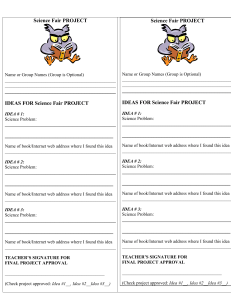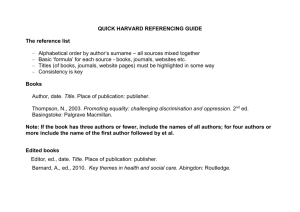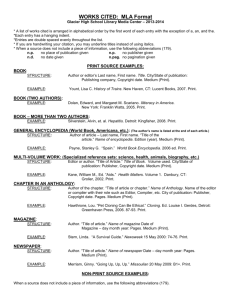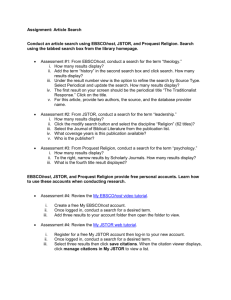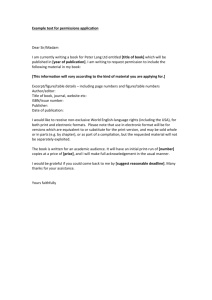Library Resources
advertisement
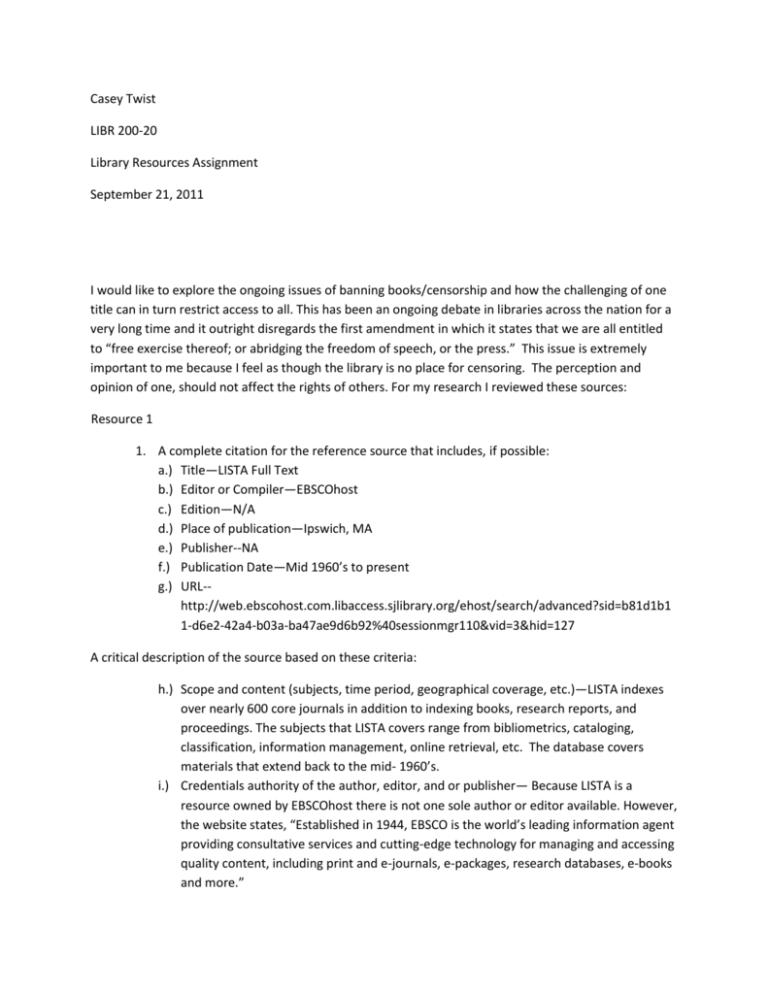
Casey Twist LIBR 200-20 Library Resources Assignment September 21, 2011 I would like to explore the ongoing issues of banning books/censorship and how the challenging of one title can in turn restrict access to all. This has been an ongoing debate in libraries across the nation for a very long time and it outright disregards the first amendment in which it states that we are all entitled to “free exercise thereof; or abridging the freedom of speech, or the press.” This issue is extremely important to me because I feel as though the library is no place for censoring. The perception and opinion of one, should not affect the rights of others. For my research I reviewed these sources: Resource 1 1. A complete citation for the reference source that includes, if possible: a.) Title—LISTA Full Text b.) Editor or Compiler—EBSCOhost c.) Edition—N/A d.) Place of publication—Ipswich, MA e.) Publisher--NA f.) Publication Date—Mid 1960’s to present g.) URL-http://web.ebscohost.com.libaccess.sjlibrary.org/ehost/search/advanced?sid=b81d1b1 1-d6e2-42a4-b03a-ba47ae9d6b92%40sessionmgr110&vid=3&hid=127 A critical description of the source based on these criteria: h.) Scope and content (subjects, time period, geographical coverage, etc.)—LISTA indexes over nearly 600 core journals in addition to indexing books, research reports, and proceedings. The subjects that LISTA covers range from bibliometrics, cataloging, classification, information management, online retrieval, etc. The database covers materials that extend back to the mid- 1960’s. i.) Credentials authority of the author, editor, and or publisher— Because LISTA is a resource owned by EBSCOhost there is not one sole author or editor available. However, the website states, “Established in 1944, EBSCO is the world’s leading information agent providing consultative services and cutting-edge technology for managing and accessing quality content, including print and e-journals, e-packages, research databases, e-books and more.” j.) Intended audience—Librarians k.) Purpose and uses: Informs librarians on several topics, current trends, and issues in the library today. l.) Arrangement and or access points—N/A m.) Currency and frequency update—Regularly maintained and added to. n.) Special features—Offers articles in different languages, offers articles as far back as the mid-1960’s, hyperlinked websites, and a list of cited authors. o.) Ease of access—LISTA is a free add on to those that have a subscription to EBSCOhost, for those who do not, access is available on a continuous basis at www.libraryresearch.com A discussion of what information you were able to locate about your term paper topic in that source and the search strategy you used to locate it. Searching LISTA in EBSCOhost was certainly easy to use. You can do several different search types by author, title, subject, etc. Advance searches call also be performed and this is the route that I took. I chose to search relevant article within the last five years which were scholarly-peer reviewed and full text. I performed a couple of different searches and finally narrowed it down to “censorship” and “banned books”. This yielded only 25 results, and surprisingly within those 25 were several very good titles that are definitely research worthy for my paper. Resource 2 1. A complete citation for the reference source that includes, if possible: a.) Title— National Center for Education Statistics. Library Statistics Program b.) Editor or Compiler— The U.S. Department of Education c.) Edition—N/A d.) Place of publication—Alexandria, VA e.) Publisher—The U.S. Department of Education f.) Publication Date—N/A A critical description of the source based on these criteria: g.) URL—http://nces.ed.gov/surveys/libraries/ h.) Scope and content (subjects, time period, geographical coverage, etc.)— Per the NCES website the goal of the National Center for Education Statistic’s website is to provide complete and clear information to serve research, education and other interested communities. NCES serves the entire United States but they do not limit their research to only the U.S. they have information that covers other nations as well. i.) Credentials authority of the author, editor, and or publisher— j.) Intended audience— The NCES is utilized by several different user including librarians, educators, researchers, judge magistrates, federal departments etc. k.) Purpose and uses: NCES provides statistics that are beneficial in several different areas such as education, annual reports, tables and figures, publications, and information and statistics on just about any topic you can muster. l.) Arrangement and or access points—It is broken down in several different searchable formats. You can search for tables and figures, publications, statistics etc...And you can also do searches within their subject guide lists. m.) Currency and frequency update—Updated daily. n.) Special features—The access to current and past statistics for just about every subject. o.) Ease of access—Open to the public A discussion of what information you were able to locate about your term paper topic in that source and the search strategy you used to locate it. I don’t actually think I will be using this site for my research. I performed several different searches while at this site and I was not successful in any. The first search I did was just a general site search; I used “banned books” in the search bar. It yielded several results but was picking up articles that dealt with “banned book bags” on school properties. I then tried to do a publication search and also had no luck. Then I searched by subject, chose “libraries” on the list and started pulling up information with the library tab. I searched for censorship, banned books, etc. and turned up nothing. I did find some wonderful information and statistics on libraries that I could possibly use for library use numbers at the very least. Resource 3 1. A complete citation for the reference source that includes, if possible: a.) Title— Ipl2- A merge between the Internet Public Library (IPL) and the Librarians' Internet Index (LII) websites. b.) Editor or Compiler—Drexel University’s College of Information Science and Technology students and a consortium of Colleges and Universities with programs in the field of library science are responsible for the development and maintenance. c.) Edition—N/A d.) Place of publication—Philadelphia, PA e.) Publisher—iSchool at Drexel f.) Publication Date—2005, and then a more detailed and interactive version in 2008 A critical description of the source based on these criteria: g.) URL—I used http://lii.org and was instantly re-directed to www.ipl.org h.) Scope and content (subjects, time period, geographical coverage, etc.)— The information provided covers a variety of dates ranging over a wide area, the website was created in 2005 and a more updated version with additional resources was added in 2008. i.) Credentials authority of the author, editor, and or publisher— The information and help is provided by trained professional librarian volunteers and graduate students in library science programs. The librarians and library helpers are from libraries and colleges and universities all around the United States, Canada, and several other areas of the world. According to the website, two major roles of this website are to educate students and to provide library services to internet users. j.) Intended audience—Library students, researchers, and those looking to utilize library services. k.) Purpose and uses: To educate students in library science degrees, to inform the public, maintain a broad and balanced collection of websites for information. l.) Arrangement and or access points—Very well arranged and easy to search online format. m.) Currency and frequency update—Updated frequently and the blog and newsfeed is updated daily. n.) Special features—Blog, Ask a Librarian, policies and mission available, well organized, links for kids, teens etc. o.) Ease of access—Free to public. A discussion of what information you were able to locate about your term paper topic in that source and the search strategy you used to locate it. I’m definitely impressed with this website and I will be back to use in the future. The information was organized and the site was easy to navigate as well as the information links provided. I performed a general search using the same two words, “censorship” and “banned books.” The first search provided 80 relevant articles on the subject and the second search returned 500 resources. Some pulled up websites that contained information on this subject, some returned book information and articles. I will be using this site to gather information for my paper. Resource 4 1. A complete citation for the reference source that includes, if possible: a.) Title— Academic Search Premier Full Text b.) Editor or Compiler—EBSCO c.) Edition—N/A d.) Place of publication—Ipswich, MA e.) Publisher-EBSCOhost f.) Publication Date— A critical description of the source based on these criteria: g.) URL-http://web.ebscohost.com.libaccess.sjlibrary.org/ehost/search/advanced?sid=979a812c -c956-4766-b7e2-5d579b363a16%40sessionmgr111&vid=1&hid=127 h.) Scope and content (subjects, time period, geographical coverage, etc.)— This database includes full text scholarly articles that include topics such as computer sciences, engineering, physics, chemistry, language, arts, literature, medical science, ethnic studies, education, etc. This publication is strictly online and can be accessed anywhere there in an internet connection and a subscription. Publication dates before 1975 to present. i.) Credentials authority of the author, editor, and or publisher— N/A Differs author to author and publication to publication j.) Intended audience—educators, librarians, researchers, college students k.) Purpose and uses: To inform supply access to print materials l.) Arrangement and or access points—Very well organized by publication and offers several search options including basic-advanced m.) Currency and frequency update—Updated daily n.) Special features—Different language searches, full text options, peer-reviewed/scholarly options, and specific date searches o.) Ease of access—Wonderful resource for those who have access to the database. A discussion of what information you were able to locate about your term paper topic in that source and the search strategy you used to locate it. I performed the same two word searches that I previously used. I did an advanced search for articles written within the last five years and I limited those to be scholarly/peer reviewed journals. Full text article option is also a feature that comes in very handy and which I took advantage of with this search as well. I used “censorship” and “libraries” in the same search and “banned books” in the second search, for the banned books search I yielded 21 results and for the “censorship” and “libraries” search, it returned 165 results. There are several interesting resources in which I have saved copies of to refer back to as I write my paper. Resource 5 1. A complete citation for the reference source that includes, if possible: a.) Title— JSTOR b.) Editor or Compiler—JSTOR/ITHAKA c.) Edition—N/A d.) Place of publication—N/A e.) Publisher—Several different publisher work with JSTOR f.) Publication Date—The library publication that I looked up had articles from 1984-2007. I did see articles from other publications date back to 1907. JSTOR’s website had a copyright of 2000-2011 A critical description of the source based on these criteria: g.) URL-- http://about.jstor.org.libaccess.sjlibrary.org/ h.) Scope and content (subjects, time period, geographical coverage, etc.)— According to the website this resources is used by millions of people for teaching, learning and researching. It is strictly non-profit and offers over a thousand academic journals, a million images, letters and other resources. They claim to be the world’s most trusted source for academic content. i.) Credentials authority of the author, editor, and or publisher— N/A j.) Intended audience—Scholars, researchers, educators, students, librarians, etc... k.) Purpose and uses: To allow access to scholarly information and academic journals l.) Arrangement and or access points—Very well organized and it is accessed online. They have recently made many of their journals free to the public. m.) Currency and frequency update—I could not find the information on the site for this question. n.) Special features—They offer free resources and free download of document viewers. They also run automated check to ensure that the website is functioning correctly. o.) Ease of access—Some parts are free to the public others you must be part of an organization that subscribes. A discussion of what information you were able to locate about your term paper topic in that source and the search strategy you used to locate it. JSTOR is a very promising site. I did my normal word searches and I retrieved several items that appeared to be beneficial to the research I have been conducting on my topic. JSTOR is very well organized, easy to navigate, and all the links and information appear to be well taken care of. I will definitely use and recommend others to JSTOR; as long as they have access through a public or private organization with a subscription they will have access. That appears to be the only downfall, subscriptions are very expensive and if you do not have then you can only retrieve certain information. Works Cited Drexel. (2011). Ipl2. Retrieved from Internet Public Library: http://www.ipl.org/ EBSCO. (2011). Academic Search Premeir. Retrieved from http://web.ebscohost.com.libaccess.sjlibrary.org/ehost/search/advanced?sid=824d3b70-175c-458f814b-4bff1ad1cfb7%40sessionmgr115&vid=1&hid=127 EBSCO. (2011). Library Information Science & Technology Abstracts. Retrieved from http://web.ebscohost.com.libaccess.sjlibrary.org/ehost/search/advanced?sid=cc553cff-9f29-4f7c-891e4d948d06e3f1%40sessionmgr110&vid=1&hid=127 Education, U. D. (2011). National Center for Educational Statistics. Retrieved from http://nces.ed.gov/ JSTOR. (2011). Retrieved from JSTOR: http://www.jstor.org.libaccess.sjlibrary.org/
